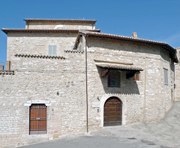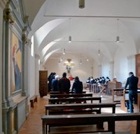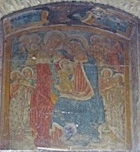


A widow named Giovanna di Ghelferio established a community of female Franciscan tertiaries in a a house near Via San Francesco, between San Paolo and San Stefano in 1392. By 1402, the community was affiliated with that of the Blessed Angelina at Sant Anna, Foligno. When Pope Martin V approved the federation under the Blessed Angelina in 1428, Sister Tommasa of San Quirico was named as the leader of the community in Assisi.
The community built a new convent at the current location on land that they bought from the Benedictine nuns of Sant’ Apollinare (later San Giuseppe).
Rosata, the widow of Mariotto di Ludovico, established a community of Franciscan tertiaries at Sant’ Antonio da Padova in 1490. However, when she died in 1509, she left all of the goods of the community to that of San Quirico. By the time of the Apostolic Visitation of Monsignor Pietro Camaiani in 1573, the community at Sant' Antonio had regained its independence but was in great poverty, and the remaining sisters were forced to move to San Quirico.


The convent was badly damaged in the earthquake of 1997; details of its subsequent restoration can be found in the website of the Associazione Nazionale Alpini.
Madonna and Child with saints (ca. 1460)

-
✴the Madonna and Child with St Anne and angels; and
-
✴SS Quiricus and St Francis to the sides.
Roman Remains on the Site
Roman remains found on the site were for a long time thought to relate to a temple, but they have recently been identified as those of the Roman baths (2nd century AD).
Return to Nunneries of Assisi.
Return to Monuments of Assisi.
Return to Walk II.
Return to the home page on Assisi.

